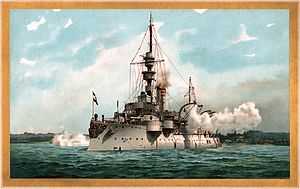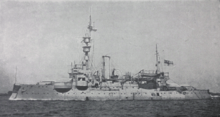SMS Odin
 1902 lithograph of Odin firing a salute | |
| Career (German Empire) | |
|---|---|
| Name: | Odin |
| Namesake: | Odin |
| Builder: | Kaiserliche Werft in Danzig |
| Laid down: | 1893 |
| Launched: | 3 November 1894 |
| Commissioned: | 22 September 1896 |
| Fate: | Struck from naval list, 16 December 1919; scrapped, 1935 |
| General characteristics as built | |
| Class and type: | Odin-class coastal defense ship |
| Displacement: | 3,754 metric tons (3,695 long tons) |
| Length: | 79 m (259.2 ft) |
| Beam: | 15.2 m (49.9 ft) |
| Draft: | 5.61 m (18.4 ft) |
| Installed power: | 4,800 ihp (3,600 kW) |
| Propulsion: | 2 shafts, 2 Triple-expansion steam engines 4 locomotive boilers |
| Speed: | 14.4 knots (26.7 km/h; 16.6 mph) |
| Range: | 2,200 nmi (4,100 km; 2,500 mi) at 10 knots (19 km/h; 12 mph) |
| Complement: | 20 officers 256 enlisted men |
| Armament: | 3 × 24 cm (9.4 in) guns 10 × 8.8 cm (3.5 in) guns 3 × 45 cm (17.7 in) torpedo tubes |
| Armor: | Waterline belt: 240 mm (9.4 in) Deck: 70 mm (2.8 in) Conning tower: 120 mm (4.7 in) |
SMS Odin [lower-alpha 1] was the lead ship of her class of coastal defense ships (Küstenpanzerschiffe) built for the German Imperial Navy. She had one sister ship, Ägir. Odin, named for the eponymous norse god, was built by the Kaiserliche Werft Danzig shipyard between 1893 and 1896, and was armed with a main battery of three 24-centimeter (9.4 in) guns. She served in the German fleet throughout the 1890s and was rebuilt in 1901–1903. She served in the VI Battle Squadron after the outbreak of World War I in August 1914, but saw no action. Odin was demobilized in 1915 and used as a tender thereafter. After the war, she was rebuilt as a merchant ship and served in this capacity until 1935, when she was broken up for scrap.
Design
Odin was 79 meters (259 ft) long overall and had a beam of 15.2 m (50 ft) and a maximum draft of 5.61 m (18.4 ft). She displaced 3,754 long tons (3,814 t) at full combat load. Her propulsion system consisted of two vertical 3-cylinder triple expansion engines. Steam for the engines was provided by four coal-fired boilers. The ship's propulsion system provided a top speed of 14.4 kn (26.7 km/h; 16.6 mph). She carried 370 t (360 long tons; 410 short tons) of coal, which gave her a range of approximately 1,490 nautical miles (2,760 km; 1,710 mi) at 10 kn (19 km/h; 12 mph). Odin had a crew of 20 officers and 256 enlisted men.[1]
The ship was armed with three 24 cm K L/35 guns mounted in three single gun turrets. Two were placed side by side forward, and the third was located aft of the main superstructure. They were supplied with a total of 204 rounds of ammunition. The ship was also equipped with ten 8.8 cm SK L/30 guns in single mounts. Odin also carried three 45 cm (18 in) torpedo tubes, two in swivel mounts on the deck amidships and one in the bow, submerged below the waterline. The ship was protected by an armored belt that was 240 mm (9.4 in) thick amidships, and an armored deck that was 70 mm (2.8 in) thick. The conning tower had 120 mm (4.7 in) thick sides.[2]
Service history

Odin was laid down at the Kaiserliche Werft shipyard in Danzig in 1893, launched on 3 November 1894, and completed on 7 July 1896, after which sea trials commenced.[3] She was commissioned into the German fleet on 22 September 1896. She served in the fleet for her entire peacetime career.[4] Odin participated in the 1900 summer fleet exercises, where she served in the squadron that simulated the German navy, alongside the recently-commissioned battleship Kaiser Friedrich III and the coastal defense ship Frithjof.[5]
In 1901, Odin was taken in hand at the Kaiserliche Werft in Danzig for an extensive reconstruction. Her old boilers were replaced with eight new Marine type boilers and her length was increased to 86.15 m (282.6 ft). This increased her displacement to 4,376 t (4,307 long tons; 4,824 short tons) at full load. The lengthened hull, which improved her hydrodynamic shape, and the improved boilers increased her speed by a full knot, to 15.5 kn (28.7 km/h; 17.8 mph). Her coal storage was increased to 580 t (570 long tons; 640 short tons), which allowed her to steam for an additional 800 nmi (1,500 km; 920 mi). The modernization work was completed by 1903, at which point she returned to active service.[1]
At the outbreak of World War I in August 1914, Odin was assigned to the VI Battle Squadron, along with her sister Ägir and the six Siegfried-class coastal defense ships. The Squadron was disbanded on 31 August 1915 to free up the ships' crews for more important tasks.[6] Odin was thereafter used as a tender in Wilhelmshaven through to the end of the war. She was stricken from the naval register on 6 December 1919 and sold. In 1922, she was rebuilt as a merchant ship at the Deutsche Werke shipyard in Rüstringen. She was operated by A. Bernstein Co., out of Hamburg. She continued in this role until 1935, when she was broken up for scrap.[4]
Footnotes
Notes
- ↑ "SMS" stands for "Seiner Majestät Schiff", or "His Majesty's Ship".
References
- Gardiner, Robert, ed. (1979). Conway's All the World's Fighting Ships 1860–1905. Greenwich: Conway Maritime Press. ISBN 0-8317-0302-4.
- Gardiner, Robert; Gray, Randal, eds. (1984). Conway's All the World's Fighting Ships: 1906–1922. Annapolis, MD: Naval Institute Press. ISBN 0-87021-907-3.
- Gröner, Erich (1990). German Warships: 1815–1945. Annapolis, MD: Naval Institute Press. ISBN 0-87021-790-9.
- "Notes on Naval Progress". General Information Series (Government Printing Office) XX. 1900.
| ||||||||||||||